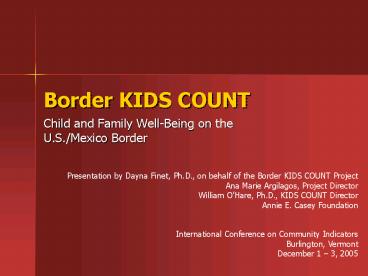Border KIDS COUNT - PowerPoint PPT Presentation
1 / 14
Title:
Border KIDS COUNT
Description:
Border KIDS COUNT. Child and Family Well-Being on the U.S. ... Border KIDS COUNT report includes 32 counties twenty-four directly border Mexico, and eight ... – PowerPoint PPT presentation
Number of Views:24
Avg rating:3.0/5.0
Title: Border KIDS COUNT
1
Border KIDS COUNT
- Child and Family Well-Being on the U.S./Mexico
Border
Presentation by Dayna Finet, Ph.D., on behalf of
the Border KIDS COUNT Project Ana Marie
Argilagos, Project Director William OHare,
Ph.D., KIDS COUNT Director Annie E. Casey
Foundation
International Conference on Community
Indicators Burlington, Vermont December 1 3,
2005
2
Border Paradox and Promise
- Political boundary separates U.S. and Mexico, yet
border communities on both sides historically
interconnected - Regional sense of place, yet distinct communities
defy single-dimensional understanding and action - Longstanding and severe problems (extreme
poverty, infrastructural deficits) co-exist with
significant strengths (integration of extended
families, bilingual and bicultural traditions)
3
Border Demographics
- 6.5 million people
- 1.8 million children
- Border population the vanguard of a massive
demographic shift, transforming the racial and
ethnic makeup of the United States within the
next century, when White population will no
longer comprise the nations majority group - Children, especially, more likely to belong to
non-White racial and ethnic groups, and
especially, to identify as Hispanic or Latino - Border states, and especially border counties,
younger and more diverse than non-Border states
and counties
4
Border Geography
- Border extends 2,000 miles, from Pacific Ocean at
the west to Gulf of Mexico at the east - Border region crosses political jurisdictions but
is not defined by them, so can be difficult to
specify - Border KIDS COUNT report includes 32
countiestwenty-four directly border Mexico, and
eight (five in Texas, three in New Mexico) are
adjacent, with strong socioeconomic resemblance
5
Border Geography
- Twenty counties in Texas, six in New Mexico, four
in Arizona, and two in California - Special case of San Diego and Los Angeles
counties - Caution interpreting data from sparsely-populated
counties
6
Border KIDS COUNT Indicators U.S. Census
- Total population
- Child population
- Latino population
- Immigration
- English language fluency
- Family structure
- Parental employment
- Child poverty
- High school dropouts
- Teens not in school and not working
7
Border KIDS COUNT Indicators Vital Statistics
- Teen births
- Low birth-weight births
- Infant mortality
8
Data Analysis Geographic Comparison
- Entire border region compared to U.S. and to
non-border states as a whole - Comparisons among border states
- Comparisons among border and non-border counties
within border states
9
Data Analysis Selected Indicators
- Demographic
- Latino population, especially children
- Immigration origin, recency, and citizenship
status - Economic
- Child poverty for all children, Latino, and
non-Latino White children
10
Selected Findings
- Magnitude of intuitive results
- Example In Texas border counties, nine out of
10 children identify as Latino - Example In border states, half the
foreign-born population comes from Mexico, while
in the U.S., three percent, and in non-border
states, one percent, of immigrants were born in
Mexico - Example At every geographic level, the
percentage of Latino children in poverty is
between three and four times higher than the
proportion of poor non-Latino White children
11
Selected Findings
- Counterintuitive results
- Example In California, the highest percentage
of foreign-born residents occurs in non-border
counties - Example In all four border states, about
one-third of immigrants arrived in the U.S. since
1990, with two-thirds arriving earlier - Example Within border states, a larger share of
border county immigrants, compared to
foreign-born residents of non-border counties,
have become U.S. citizens
12
Selected Findings
- Texas (and New Mexico) and California (and
Arizona) influence and contrast in the border
region
13
Continuing Research
- Examination of remaining Border KIDS COUNT
indicators - Example Teen births and high school dropouts
- Additional analyses within states and at county
level - Example Rural and urban counties, cities and
sister cities - Extended set of variables
- Example Environmental, housing, and health
- Extended variety of data
- Example Ethnographic research
- Comparable data from northern Mexico
14
Implications for Practice
- Strategic communication with policy-makers,
journalists, advocates, community stakeholders - Local partnerships to leverage public and private
resources and investments































